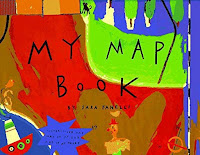Heart Mapping is a component of Atwell’s Writing Workshop Procedure that it just beautiful and seeing student heart maps on the walls at the Center for Teaching and Learning (CTL) was really powerful. At CTL, Atwell’s methods are utilised day in and day out, and they work. Students write confidently, they edit rigorously, and they confer regularly with their teachers and peers.
I borrowed a few texts, including Georgia Heard's Heart Maps, at the end of my first day at CTL, just to truly inhabit my persona as ‘edugeek’ – I flew halfway around the world to learn from the students and teachers at the school so why not have a look at the Professional Library – these teachers are masters – I needed to know what they read!
Six Reasons for Heart Mapping:
1. Authentic writing comes from the heart. It gives writers a chance to connect with what is important to them, what they feel, think, and care deeply about.
2. Heart mapping opens the door to literacy for all writers – including reluctant, struggling, and blocked writers. Those who feel unable to engage with conventional forms of writing, feel they haven’t the time, or confidence can reconnect through heart mapping.
3. Heart maps can function as a practical touchstone for writers. A heart map provides the way back to what is essential in a writer’s life, breaking down blocks, and providing a concrete place to work from.
4. Heart mapping taps into the power of visual learning. Visuals sing to the brain and the heart shape connects the writer to what is important to them on an emotional level.
5. Heart mapping gives writers the freedom to explore and allows an idea or image room to grow. Using heart maps steers writers away from reductive and restrictive school genres (such as the five-paragraph essay). The map is about sparking joy in the writing process.
6. Heart mapping connects us to our feelings and helps us empathise with others. Through writing our stories we learn that humans share experiences and ultimately our joys, pain, fear, and elation can be felt by those around us.
So how does Heard begin the process? By sharing her own. Thinking aloud whilst writing down what is most significant in the centre and then filling the heart with other things whilst sharing the stories with the writers about to go on their own heart mapping journey.
- Use heart maps at the start of a genre study.
- Writers can go back to their maps routinely to add extra topics, revise.
Heart Mapping Considerations:
Where will the most significant inclusions be positioned?
What size font will be used and does this symbolise anything?
Will you draw, write, collage (letters/photographs/images etc.)?
What colours will be used and what do these symbolise?
Will you include a key?
The book is filled with a range of templates for heart mapping exercises. See the 'Heart Mapping and Writing Presented by Georgia Heard' for an overview or visit Heinemann for a sample chapter.
Further Reading:
Awakening the Heart: Exploring Poetry in Elementary and Middle School - Georgia Heard, 1999.
Publisher: Heinemann, Portsmouth
ISBN: 978-0-325-00093-0
My Map Book - Sara Fanelli, 2001
Publisher: Harper Collins Publishers, New York
ISBN: 978-0-060-26455-0



No comments:
Post a Comment